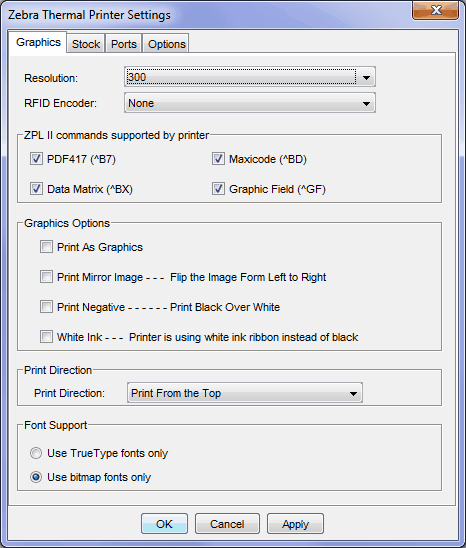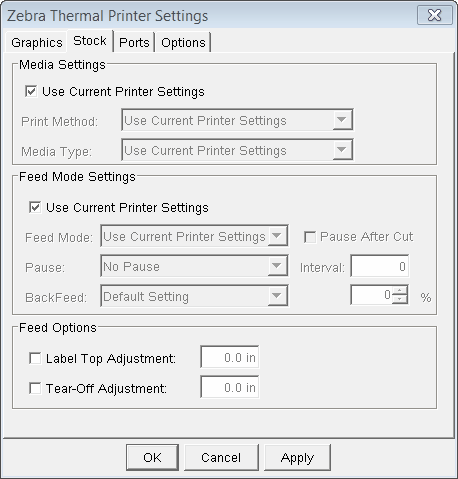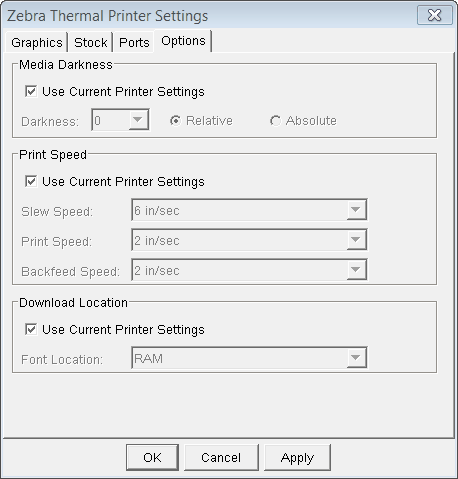PEERNET Zebra Thermal Printer
The PEERNET Zebra Thermal Printer allows for the production of labels on most Zebra model printers. Label formats are generated and printed in a WYSIWYG format, allowing access to the printers' built-in typefaces, integrated bar code support, and many other printer-specific features.
The PEERNET Zebra Thermal Printer will use the Zebra printers' native command syntax to generate label formats where possible. Those features that are not supported by your particular Zebra printer will be simulated by rendering them as graphics.
The configuration dialog for this printer contains 4 tabs that allow you to configure various aspects of the printer.
Configuration Options - Graphics Settings

Zebra Configuration Dialog - Graphics Options
Resolution
This setting controls the resolution of the output at the physical printer in dots per inch (dpi). You can currently choose from 4 settings: 152 dpi, 203 dpi, 300 dpi, or 600 dpi. The default setting is 300 dpi.
RFID Encoder
This settings allows you to specify the type of RFID encoder that is present in your printer. The default setting is Disabled, as not all Zebra printers contain an integrated RFID encoder. Consult your printers' documentation for details on the RFID encoder included with your printer (if any).
ZPL II Command Support
This section allows for specification of items that may not necessarily be natively supported on all Zebra printer models. Items that are selected are assumed to be natively supported by the printer, and native commands will be generated to print them. If one or more of these items are not natively supported by your Zebra printer, unselecting them will cause the PEERNET Reports Designer to simulate them by rendering them as graphic images.
Graphics Options
These options control how graphics are treated on the label format, and how the overall label format is generated.
Print As Graphics - when selected, this option causes the entire label format to be treated as a graphic or a series of graphic images, and essentially bypasses all native support for any item, including text, bar codes, lines and other natively supported elements.
Print Mirror Image - when selected, this option will attempt to print the label as a mirror image of what is currently displayed in the design view by flipping the elements of the label from left to right.
Print Negative - when selected, this option will attempt to print the label as a negative image, with all white portions printed black and all black portions printed white.
Print Direction
This section controls where the top of form on the label is located relative to the direction of printing. The default for this setting is Print From the Top.
Font Support
Many Zebra printers include native support for both bitmap fonts and True Type fonts. The options presented here allow you to select which type of font to use.
Use True Type fonts only - when this option is selected, PEERNET Reports Designer will create and download True Type fonts to the printer to render any text that is on a label or report design. True Type fonts allow for proper scaling, resulting in potentially fewer fonts being downloaded to the printer. This can have a direct impact on speed (especially in large batches or in label or report designs that use multiple sizes of a single font) and the amount of data transmitted to the printer.
Use bitmap fonts only - when selected, this option will instruct PEERNET Reports Designer to create and download bitmap fonts to the printer to render any text that is on a label or report design. Using bitmap fonts on labels or reports with large amounts of text typically results in a larger amount of data transmitted to the printer and slower printing (especially in large batches).
We highly recommend using True Type fonts for any label or report designs if possible. Using True Type fonts will generate smaller label and report layouts when they are generated for the printer, and they scale much better than bitmap fonts (which actually do not scale). |
Configuration Options - Stock Settings

Stock Options tab of the Zebra Configuration Dialog
Media Settings
These options allow you to control the specifics about the stock that you are using in your printer and how the printer functions to actually print data on the stock.
If the Use Current Printer Settings checkbox is selected, all other options in the Media Settings group are disabled and any customizations for these settings are taken from the printer itself. This allows you to make changes to these settings at the printer console itself without having to change these settings here for several different label formats that are going to the same printer.
Print Method - this allows you to specify what kind of media to use, either Direct Thermal or Thermal Transfer. The Direct Thermal setting indicates that the printer will not use a ribbon to print; in this case, the stock used must be heat sensitive. The Thermal Transfer setting results in the use of a ribbon to print. Consult your printers' documentation for more details regarding which media type is the most appropriate for your printer.
Media Type - this setting allows you to configure how the labels are arranged on the stock that you are currently using. Continuous is generally used for stock where the labels are arranged without any kind of physical separator between individual labels. Non-Continuous (Web Sensing) is used for those stocks where the labels are arranged with physical gaps between them. Non-Continuous (Mark Sensing) is typically used when the labels on the stock are arranged with some sort of reflective mark used to separate individual labels.
Feed Mode Settings
All feed mode options allow the user to specify actions to take place after a label or several labels is/are printed. Many of the options available here rely on specific functionality of the printer (such as the presence of a cutter). In these cases, it is necessary to consult your printers' documentation to determine whether a specific feed mode action is valid for your particular printer.
Feed Mode - specifies the action to take after a particular number of labels has been printed (by default, after each label is printed). The default setting is Use Current Printer Settings, which will cause the feed action that has been previously configured at the printer console to occur. Available actions here are Tear Off, Peel Off, Rewind, Cut and Applicator.
When Tear-Off is specified, labels are presented in such a way to allow the user to simply tear the label off using the tear bar. This is the most commonly used setting, and is typically used with the Pause option to allow for easy removal of a printed label from the label stock.
When Peel-Off is specified, the printer automatically pauses after printing a label to facilitate the removal of the label from the label backing by the operator. This is done by using an optional sensor called a Present Sensor, which detects the presence or absence of a label, rather than the gap or mark between labels. This setting is really only useful when the media type is set to anything other than Continuous.
When Rewind is specified, the printer will make use of an external attachment that is available for some Zebra printers, which winds printed labels onto an external 'take-up' spool, rather than simply spilling out onto the floor. If the external rewind attachment is not present, this setting will turn off the default "back feed" motion that occurs between labels.
When Cut is specified, the printer will print the label and perform a physical cut, provided the printer is equipped with a cutter. If there is no cutter present, this command is ignored, as well as any associated specification for the occurrence of the cut action.
When Applicator is specified, this setting enables the applicator that comes with a print-and-apply engine. Note that this option is ignored if there is no applicator present or if you are not using a print-and-apply engine.
Pause After Cut - Used in conjunction with the Cut action, when selected this setting causes the printer to pause printing the next label after the cut is made.
Backfeed - specifies when the label stock will be rewound, if at all.
Occurrence - allows the user to change when the specified feed mode is done.
Interval - Used in conjunction with the 'After Specified Interval' setting of the Occurrence drop-down, allows the user to specify the number of labels to print before the selected post-print action is performed. This value is independent of the number of copies to print. This setting has a range of 1 to 9999 with a default value of 1, and is ignored completely if the value for Occurrence is anything other than 'After Specified Interval'.
Percentage - This option is enabled when the backfeed behaviour is set to 'Specified Percentage', and allows the backfeed distance to be specified as a percentage of the label height.
Label Top Adjustment - this option allows the user to indicate a vertical adjustment of the point where printing will begin on the next label. Essentially, this setting controls the distance that the printed label will be presented to the user so that it can be torn off, cut, or stripped from the label backing.
Tear-Off Adjustment - specifies an extra distance to advance the label stock after each printed label.
|
Minimum Value |
Maximum Value |
||
|
Imperial (in) |
Metric (mm) |
Imperial (in) |
Metric (mm) |
Label Top Adjustment |
-3.94 |
-10.0 |
3.94 |
10.0 |
Tear-Off Adjustment |
-3.94 |
-10.0 |
3.94 |
10.0 |
Configuration Options - Options Settings

Options tab of the Zebra Configuration Dialog
These settings allow the user to exert fine-grain control of several Zebra printer options, including print speeds, print head function, post-print actions and printer memory settings.
Media Darkness Settings
These settings allow the user to make adjustments to the darkness setting of the print head.
If the Use Current Printer Settings checkbox is selected, all other options in the Media Darkness Settings group are disabled and any customizations for these settings are taken from the printer itself. This allows you to make changes to these settings at the printer console itself without having to change these settings here for several different label formats that are going to the same printer.
Darkness - specifies the amount of heat applied by the print head to the media, which has the effect of lightening or darkening the print contrast. The default specifies a darkness value of 0. In addition, the value specified for the media darkness can be specified as an absolute or relative setting. A darkness that is specified as absolute replaces any previous setting for the media darkness, while a darkness that is specified as relative is added to the current media darkness setting.
Print Speed Settings
The options presented here allow you to make adjustments to the various speed settings available on Zebra printers.
If the Use Current Printer Settings checkbox is selected, all other options in the Print Speed Settings group are disabled and any customizations for these settings are taken from the printer itself. This allows you to make changes to these settings at the printer console itself without having to change these settings here for several different label formats that are going to the same printer.
Print Speed - specifies the rate at which labels are printed. The default is to use the current printer settings.
Backfeed Speed - specifies the rate at which label stock will reverse to align to the next start of print position. The default is to use the current printer settings.
Slew Speed - specifies the rate of rotation of the drum that holds the label stock in place for printing. The default is to use the current printer settings.
|
Minimum Speed |
Maximum Speed |
||
|
Imperial (in) |
Metric (mm) |
Imperial (in) |
Metric (mm) |
Print Speed |
2.0 |
50.8 |
12.0 |
304.8 |
Backfeed Speed |
2.0 |
50.8 |
12.0 |
304.8 |
Slew Speed |
2.0 |
50.8 |
12.0 |
304.8 |
Memory Settings
Font Download Location
Zebra printers allow the users a certain amount of control over where fonts and image information can be downloaded and how much of the printers' memory can be used for such purposes. Memory capacity varies by printer model, as does expansion capability.
This setting allows you to specify which memory location is used for storage of downloaded fonts and images. Valid values include RAM, Onboard Flash, and Memory Card.
If the Use Current Printer Settings checkbox is selected, all other options in the Font Download Location group are disabled and any customizations for these settings are taken from the printer itself. This allows you to make changes to these settings at the printer console itself without having to change these settings here for several different label formats that are going to the same printer.
Limitations
1. The following bar codes are not fully supported by Zebra printers, and will always be simulated as graphics when printed:
•All 4-State bar codes
•Anker
•Planet
•Facing Identification Mark (FIM)
•Plessey
•MSI
•Industrial 2 of 5
•Standard 2 of 5
•SCC-14
•SSCC-18
•Matrix 2 of 5
2. The following bar codes are simulated as graphics only under certain conditions:
•PDF417
PEERNET Reports Designer will make every attempt to generate this bar code using native command syntax; however, this bar code will be simulated as a graphic if any of the following conditions are met:
othe specified number of columns is outside the acceptable range of 1 - 30, or
othe specified number of rows is outside the acceptable range of 3 - 90, or
othe calculated product of the rows and columns used in the symbol is greater than the maximum of 928, or
othe data contains an initialization character, or
othe specified ECC level is outside the acceptable range of 0 - 8
•DataMatrix
This bar code will be simulated as a graphic if the specified number of rows and columns are not equal, as Zebra printers do not support rectangular DataMatrix bar codes.
3. The following graphic items are not natively supported by the Zebra command syntax, and are simulated as graphics:
•Arcs
•Polygons
4. PEERNET Reports Designer does not make use of any fonts that are built-in to the Zebra printer, including any supplied internal bitmapped fonts, smooth fonts, scalable fonts, and any international fonts. All fonts used in labels created with PEERNET Reports Designer are generated as bitmapped fonts on the fly, and are downloaded to the printer on an as-needed basis.
5. Plessey and MSI bar codes generated through the printers' native command syntax are visibly different from simulated versions generated with the same data. This is due to the differences in how bar widths and bar ratios are handled in each case. Native and simulated versions of these bar codes are equally valid and will scan properly, although the simulated version will typically occupy less space on the label.
